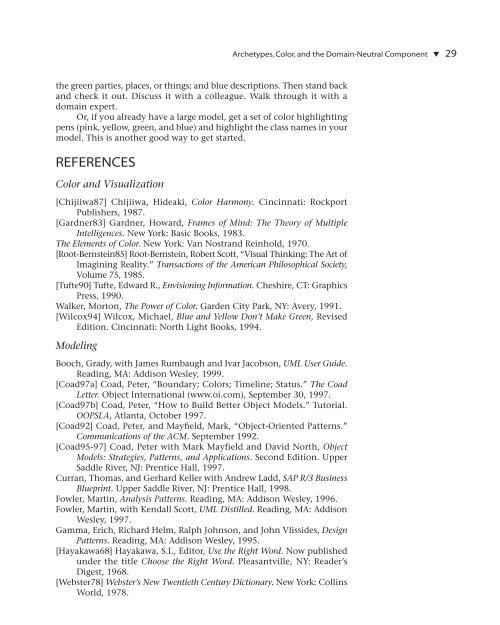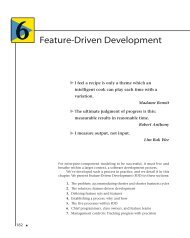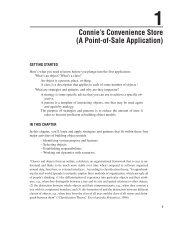Archetypes, Color, and the Domain-Neutral ... - Petercoad.com
Archetypes, Color, and the Domain-Neutral ... - Petercoad.com
Archetypes, Color, and the Domain-Neutral ... - Petercoad.com
Create successful ePaper yourself
Turn your PDF publications into a flip-book with our unique Google optimized e-Paper software.
<strong>Archetypes</strong>, <strong>Color</strong>, <strong>and</strong> <strong>the</strong> <strong>Domain</strong>-<strong>Neutral</strong> Component ▼ 29<strong>the</strong> green parties, places, or things; <strong>and</strong> blue descriptions. Then st<strong>and</strong> back<strong>and</strong> check it out. Discuss it with a colleague. Walk through it with adomain expert.Or, if you already have a large model, get a set of color highlightingpens (pink, yellow, green, <strong>and</strong> blue) <strong>and</strong> highlight <strong>the</strong> class names in yourmodel. This is ano<strong>the</strong>r good way to get started.REFERENCES<strong>Color</strong> <strong>and</strong> Visualization[Chijiiwa87] Chijiiwa, Hideaki, <strong>Color</strong> Harmony. Cincinnati: RockportPublishers, 1987.[Gardner83] Gardner, Howard, Frames of Mind: The Theory of MultipleIntelligences. New York: Basic Books, 1983.The Elements of <strong>Color</strong>. New York: Van Nostr<strong>and</strong> Reinhold, 1970.[Root-Bernstein85] Root-Bernstein, Robert Scott, “Visual Thinking: The Art ofImagining Reality.” Transactions of <strong>the</strong> American Philosophical Society,Volume 75, 1985.[Tufte90] Tufte, Edward R., Envisioning Information. Cheshire, CT: GraphicsPress, 1990.Walker, Morton, The Power of <strong>Color</strong>. Garden City Park, NY: Avery, 1991.[Wilcox94] Wilcox, Michael, Blue <strong>and</strong> Yellow Don’t Make Green, RevisedEdition. Cincinnati: North Light Books, 1994.ModelingBooch, Grady, with James Rumbaugh <strong>and</strong> Ivar Jacobson, UML User Guide.Reading, MA: Addison Wesley, 1999.[Coad97a] Coad, Peter, “Boundary; <strong>Color</strong>s; Timeline; Status.” The CoadLetter. Object International (www.oi.<strong>com</strong>), September 30, 1997.[Coad97b] Coad, Peter, “How to Build Better Object Models.” Tutorial.OOPSLA, Atlanta, October 1997.[Coad92] Coad, Peter, <strong>and</strong> Mayfield, Mark, “Object-Oriented Patterns.”Communications of <strong>the</strong> ACM. September 1992.[Coad95-97] Coad, Peter with Mark Mayfield <strong>and</strong> David North, ObjectModels: Strategies, Patterns, <strong>and</strong> Applications. Second Edition. UpperSaddle River, NJ: Prentice Hall, 1997.Curran, Thomas, <strong>and</strong> Gerhard Keller with Andrew Ladd, SAP R/3 BusinessBlueprint. Upper Saddle River, NJ: Prentice Hall, 1998.Fowler, Martin, Analysis Patterns. Reading, MA: Addison Wesley, 1996.Fowler, Martin, with Kendall Scott, UML Distilled. Reading, MA: AddisonWesley, 1997.Gamma, Erich, Richard Helm, Ralph Johnson, <strong>and</strong> John Vlissides, DesignPatterns. Reading, MA: Addison Wesley, 1995.[Hayakawa68] Hayakawa, S.I., Editor, Use <strong>the</strong> Right Word. Now publishedunder <strong>the</strong> title Choose <strong>the</strong> Right Word. Pleasantville, NY: Reader’sDigest, 1968.[Webster78] Webster’s New Twentieth Century Dictionary. New York: CollinsWorld, 1978.




